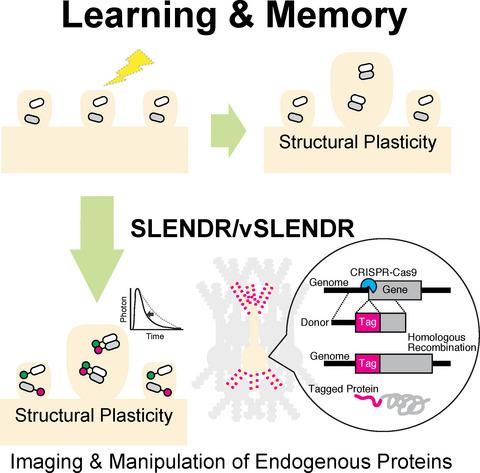当前位置:
X-MOL 学术
›
Eur. J. Nerosci.
›
论文详情
Our official English website, www.x-mol.net, welcomes your feedback! (Note: you will need to create a separate account there.)
Methodological approaches to understand the molecular mechanism of structural plasticity of dendritic spines
European Journal of Neroscience ( IF 3.4 ) Pub Date : 2020-04-05 , DOI: 10.1111/ejn.14734 Takayasu Mikuni 1, 2 , Motokazu Uchigashima 1
European Journal of Neroscience ( IF 3.4 ) Pub Date : 2020-04-05 , DOI: 10.1111/ejn.14734 Takayasu Mikuni 1, 2 , Motokazu Uchigashima 1
Affiliation

|
Dendritic spines are tiny protrusions emanating from the neuronal dendrites, typically housing single excitatory postsynapses. Structural plasticity of dendritic spines is considered to be essential for synaptic functional plasticity and also reorganization of neural circuits during learning and memory. Structural plasticity of spines is mediated by complex biochemical signaling with various spatial and temporal scales. A variety of methods based on pharmacological, genetic, molecular, imaging and optical approaches has been developed and applied to dissect the complex signal transduction pathways. In this review, we overview both conventional and new methodological approaches to identify, monitor and manipulate key molecules for structural plasticity of dendritic spines, ultimately aiming to understand the molecular mechanism of learning and memory in behaving animals.
中文翻译:

了解树突棘结构可塑性的分子机制的方法论方法
树突棘是从神经元树突发出的微小突起,通常容纳单个兴奋性突触后。树突棘的结构可塑性被认为对于突触功能可塑性以及学习和记忆过程中神经回路的重组至关重要。棘的结构可塑性是由具有各种空间和时间尺度的复杂生化信号介导的。基于药理学、遗传学、分子学、成像和光学方法的多种方法已被开发并应用于剖析复杂的信号转导途径。在这篇综述中,我们概述了识别、监测和操纵树突棘结构可塑性的关键分子的传统和新方法学方法,
更新日期:2020-04-05
中文翻译:

了解树突棘结构可塑性的分子机制的方法论方法
树突棘是从神经元树突发出的微小突起,通常容纳单个兴奋性突触后。树突棘的结构可塑性被认为对于突触功能可塑性以及学习和记忆过程中神经回路的重组至关重要。棘的结构可塑性是由具有各种空间和时间尺度的复杂生化信号介导的。基于药理学、遗传学、分子学、成像和光学方法的多种方法已被开发并应用于剖析复杂的信号转导途径。在这篇综述中,我们概述了识别、监测和操纵树突棘结构可塑性的关键分子的传统和新方法学方法,




























 京公网安备 11010802027423号
京公网安备 11010802027423号